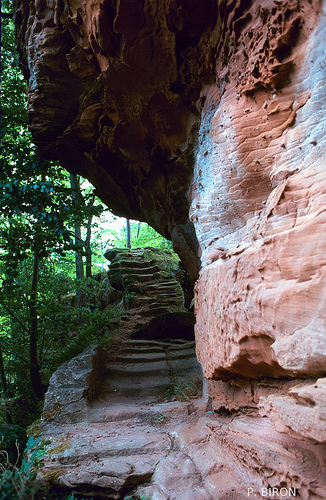

Location: Dambach, Bas- Rhin department Map
The Château de Hohenfels, also known as Hohenfels Castle, is a medieval ruined castle located in the Northern Vosges region of northeastern France. A semi-troglodytic (rock-hewn) fortress, it epitomizes the feudal architecture of Alsace, carved into a sandstone outcrop for defensive purposes. First documented in 1293, the castle has a history of multiple destructions and reconstructions, reflecting the region’s turbulent past. Classified as a monument historique since 1985, it now serves as a site of archaeological significance and a destination for hikers, drawing visitors to its evocative ruins set within a forested landscape.
Located in the commune of Dambach in the Bas-Rhin department of the Grand Est region (formerly Alsace), the Château de Hohenfels is approximately 13 km from the nearest train station. It is situated in the woods west of Dambach village, at an altitude of about 300 meters on a narrow rocky spur within the Vosges du Nord Regional Nature Park. Its coordinates are 49°00′11″N 7°36′50″E. Access requires a moderate 45-minute hike from nearby trails, starting from points such as Dambach or surrounding forest paths, which offer scenic views of the valleys and hills. The castle’s strategic placement allowed it to monitor access roads toward Lorraine, enhancing its defensive role.
The Château de Hohenfels was constructed in the late 13th century,
with its first historical mention in 1293. It was likely built by the
lords of Hohenfels, who served as ministeriales (knightly vassals) to
the Bishop of Speyer. Initially owned by the Lords of Ettendorf until
the mid-14th century, ownership shifted in 1369 when three-quarters of
the castle was sold to Ulrich von Finstingen. By 1383, half had passed
to the Counts of Leiningen through marriage alliances.
The castle’s
history is punctuated by repeated conflicts and destructions. It was
first razed in 1423 (or 1426, according to some sources) by troops from
Strasbourg and Haguenau during regional feudal disputes. Rebuilt
afterward, it was destroyed again in 1525 during the German Peasants’
War, a widespread uprising against feudal lords. Following another
reconstruction, the castle met its final destruction in 1679 when French
troops under Louis XIV burned it during the Franco-Dutch War, after
which it was abandoned and never rebuilt. Hohenfels is notable for being
the first castle in Alsace to undergo scientific archaeological
excavations, providing valuable insights into medieval life and
construction techniques. While no prominent legends or ghostly tales are
associated with the site, its role in controlling trade routes
highlights its strategic importance in medieval border politics.
As a semi-troglodytic castle, Hohenfels is intricately integrated
into a bifurcated sandstone rocky spur, divided into two sections by a
dry moat carved from the rock. The design originally spanned six floors,
emphasizing verticality for surveillance and defense. Key features
include a surrounding wall of large dressed stones enclosing the lower
courtyard, remnants of an older enclosing wall, and a cistern hewn into
the sandstone with an innovative water collection system to ensure
self-sufficiency during sieges.
The lower courtyard retains wall
fragments and another cistern, while a western platform features sparse
ruins and a room excavated directly from the rock, showcasing the
troglodytic elements. The eastern end houses the remnants of the manor
house (logis), with its north wall of dressed stones surviving up to
three levels. Additional vestiges include ruined walls, rock-cut stairs,
rooms, and a well, all adapted to the natural terrain. Modifications in
the 15th century likely strengthened its fortifications, but the overall
layout prioritized impregnability through natural barriers, such as the
rock-cut ditch separating it from the hill crest. This rock-hewn
approach, typical of Vosges castles, blends man-made structures with the
landscape for both practicality and camouflage.
Today, the Château de Hohenfels exists as atmospheric ruins, with
limited accessible areas; the top of the rocky spur is off-limits due to
safety concerns and erosion. It is state-protected as a monument
historique under the French Ministry of Culture, with preservation
efforts focused on stabilization and archaeological study rather than
reconstruction. The site is freely accessible year-round, though
visitors are advised to wear sturdy walking shoes due to uneven terrain
and to bring a packed lunch for longer outings.
Guided tours are
available in French, German, and English for groups of up to 30 people,
offering deeper insights into its history. Pets are permitted, making it
family-friendly for hikes. As part of the Vosges du Nord’s castle trail,
it attracts outdoor enthusiasts, with visitors praising the serene
forest setting and panoramic views, though it is less frequented than
larger sites like Fleckenstein. As of August 2025, no major ongoing
restorations are noted, but its inclusion in regional tourism
underscores its significance as a symbol of Alsace’s medieval heritage.